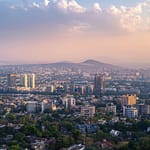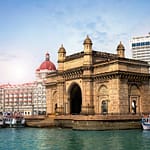Kolkata Airport, also known as Netaji Subhas Chandra Bose International Airport, is a major hub for air travel in eastern India. Many travellers wonder about its layout and facilities when planning their trips.
Kolkata Airport has one main terminal, called Terminal 2, which handles both domestic and international flights. This integrated terminal makes it easy for passengers to move between different types of flights. The airport used to have separate areas for domestic and international travel, but now everything is under one roof.
CCU, the airport code for Kolkata Airport, serves millions of passengers each year. The single terminal design helps streamline operations and improve the travel experience. Travelers can find all the services they need in one place, from check-in counters to shops and restaurants.
Overview of Kolkata Airport
Kolkata Airport, officially known as Netaji Subhas Chandra Bose International Airport (CCU), is the main air hub in Eastern India. It serves the city of Kolkata and surrounding areas in West Bengal.
The airport has two terminals: Terminal 1 and Terminal 2.
– (T1) Terminal 1 is the older facility, primarily used for domestic flights.
– (T2) Terminal 2 is a newer, integrated terminal that handles both domestic and international traffic.
Terminal 2 opened in 2013 and features modern amenities. It can handle up to 25 million passengers annually. The terminal’s design incorporates elements of Bengali culture and architecture.
Key features of Kolkata Airport:
- 24/7 operations
- Two runways
- Multiple airline lounges
- Duty-free shops
- Restaurants and cafes
- Car rental services
- Public transportation links
Kolkata Airport connects to major cities across India and international destinations in Asia and beyond. It serves as a gateway to northeastern India and nearby countries like Bangladesh and Bhutan.
The airport has seen steady growth in passenger numbers over recent years. It plays a crucial role in the economic development of West Bengal and the eastern region of India.
Terminals and Their Services
Kolkata Airport has several terminals to handle different types of flights and cargo. Each terminal offers specific services to meet passenger needs.
Domestic Terminal – Terminal 1
The old domestic terminal, known as Terminal 1, is no longer in use. It was closed when the new integrated terminal opened. All domestic flights now operate from the integrated terminal.
International Terminal – Terminal 2
Terminal 2 is the main terminal at Kolkata Airport. It handles both domestic and international flights. This modern terminal has five floors where all flight operations and administration take place.
The terminal offers many services for travellers:
- Duty-free shops
- Restaurants and cafes
- Lounges for relaxation
- Wi-Fi access
- Flight information displays
Four lounges are available for passengers:
- Travel Club Lounge Annex
- Three other lounges (names not specified)
Integrated Terminal
The integrated terminal at Kolkata Airport is a state-of-the-art facility. It can handle up to 25 million passengers per year. This terminal combines domestic and international services in one building.
Key features of the integrated terminal:
- Modern design
- Efficient check-in and security processes
- Comfortable waiting areas
- Wide range of shops and dining options
The integrated terminal has made Kolkata Airport the first in India to offer domestic and international services in a single building.
Cargo Terminal
Kolkata Airport has a dedicated cargo terminal. This terminal handles the shipping and receiving of goods. It plays a key role in supporting trade and commerce in the region.
The cargo terminal likely offers:
- Storage facilities
- Customs clearance services
- Loading and unloading equipment
- Security measures for valuable cargo
However, specific details about the cargo terminal’s operations and capacity were not provided in the search results.
Airline Information
Kolkata Airport serves numerous domestic and international carriers. It offers a wide range of flight options for travellers.
Domestic Airline Carriers
Air India operates regular flights from Kolkata to major Indian cities. IndiGo is a popular low-cost carrier with frequent domestic connections. SpiceJet and Vistara also provide service to various destinations within India.
Jet Airways, though currently not operational, previously offered flights from Kolkata. Go Air connects Kolkata to several cities across the country.
These airlines typically operate from Terminal 2, which handles both domestic and international flights.
International Airline Partners
Kolkata Airport serves as a gateway to international destinations. Emirates offers flights connecting Kolkata to Dubai and beyond. Qatar Airways links the city to Doha and other global destinations.
Singapore Airlines provides service to Singapore, facilitating connections to Southeast Asia and beyond. Bhutan Airlines and Biman Bangladesh operate regional flights to neighbouring countries.
Air Asia offers budget-friendly options for international travel. Blue Dart, while primarily a cargo carrier, also operates some passenger services.
These international flights operate from the integrated Terminal 2, allowing for smooth connections with domestic services.
Airport Facilities and Amenities
Kolkata Airport offers a range of services to make travel comfortable and convenient. Passengers can find places to relax, eat, shop, and take care of practical needs.
Lounges and Relaxation
The airport has lounges at multiple locations for both domestic and international departures. These lounges provide a quiet space to unwind before flights. Travelers can enjoy plush seating and complimentary Wi-Fi.
Many lounges offer a selection of food and drinks. Passengers can read national and international newspapers and magazines. Some lounges may have spa services for extra relaxation.
The Travel Club Lounge is a popular option for many travellers. It offers a calm environment away from the busy terminal.
Food and Retail Services
Kolkata Airport has many places to eat and shop. Travelers can find both quick snacks and full meals. There are coffee shops, fast food outlets, and sit-down restaurants.
The airport also has duty-free shops in the international terminal. These stores sell perfumes, alcohol, and other goods at tax-free prices. Regular retail shops offer local souvenirs, books, and travel essentials.
Passengers can buy last-minute gifts or pick up items they forgot to pack. Food courts provide a variety of cuisine options to suit different tastes.
Currency Exchange and ATMs
For international travelers, the airport provides currency exchange services. These help passengers convert money to Indian rupees or other currencies. Exchange counters are located in convenient spots throughout the terminal.
ATMs are available for cash withdrawals. They are placed in easy-to-find areas in both domestic and international sections. Travelers can access their bank accounts or get cash advances on credit cards.
It’s a good idea to inform your bank of travel plans to avoid card issues abroad. Some ATMs may have withdrawal limits, so check with your bank before traveling.
Luggage and Storage Services
Kolkata Airport offers luggage storage for passengers who need to leave bags for a short time. This service is useful for those with long layovers or early check-outs from hotels.
The airport also provides trolleys free of charge to help move heavy bags. Luggage wrapping services are available for added protection during travel.
For lost items, there is a lost and found office. Passengers can check here if they misplace belongings in the airport. It’s always wise to keep valuable items in carry-on bags for safekeeping.
Connectivity and Transportation
Kolkata Airport offers many ways to get to and from the city. Travelers can use buses, taxis, and soon the metro. The airport also has parking and pickup areas for those driving.
Public Transport Access
Buses run often between the airport and central Kolkata. The cheapest option is the state-run bus service. It goes to places like Esplanade and Howrah. Private AC buses also run on this route. They cost more but are more comfy.
Taxis are easy to find at the airport. Pre-paid taxis have set fares based on where you’re going. This helps avoid haggling. App-based ride services like Uber and Ola also work here.
For those going to Northeast India or nearby countries, the airport is a key hub. It links to many cities in the region.
Parking and Pickup Zones
The airport has large parking areas for both short and long stays. Short-term parking is near the terminals. It’s good for pickups and drop-offs. Long-term parking is a bit farther but costs less per day.
There are special zones for app-based taxis and private cars to pick up passengers. These areas help reduce traffic jams near the terminals.
Hotels near Kolkata Airport often offer shuttle services. This is handy for travellers with early flights or long layovers.
Kolkata Metro Expansion
A new metro line to the airport is being built. This will link the airport to the city’s metro system. It will make trips to and from the airport faster and easier.
The airport metro station will be right next to the terminal buildings. This means travellers won’t need to walk far with their bags.
When finished, the metro will be the quickest way to reach central Kolkata. It will also help cut down on road traffic to the airport.
Airport Operations
Kolkata Airport handles millions of passengers and thousands of flights yearly. Its operations involve complex systems and infrastructure to ensure safe and efficient air travel.
Air Traffic Management
The Air Traffic Control (ATC) tower at Kolkata Airport manages all aircraft movements. It coordinates takeoffs, landings, and ground traffic. The ATC uses advanced radar and communication systems to guide planes safely.
Air traffic at Kolkata Airport has grown steadily. In recent years, the airport has seen a rise in both domestic and international flights. This increase has led to more aircraft movements and busier runways.
To handle the growth, the airport has updated its air traffic management systems. These upgrades help controllers manage more flights while maintaining safety standards.
Airport Infrastructure
Kolkata Airport’s infrastructure is crucial for its operations. The airport has multiple runways to handle different types of aircraft. Recent runway expansions have allowed larger planes to land and take off.
The airport’s terminals process thousands of passengers daily. They house check-in counters, security checkpoints, and baggage systems. The new integrated terminal can handle 25 million passengers a year.
Cargo facilities at the airport manage freight traffic. These areas have special equipment for loading and unloading goods. The airport has seen growth in cargo tonnage, reflecting increased trade through Kolkata.
Additional Services
Kolkata Airport offers a range of services to make travel easier and more comfortable. From basic amenities to premium offerings, passengers can find what they need.
Customer Services
The airport has free Wi-Fi for all travellers. This lets people check emails or browse the web while waiting for flights.
There’s also a Lost and Found office. It helps passengers who have misplaced items during their journey.
Prayer rooms are available for those who wish to use them. These quiet spaces allow for religious observance.
For news and entertainment, the airport provides newspapers and TVs in waiting areas. This helps pass the time before boarding.
The Baggage Claim area is efficient. It aims to reunite travellers with their luggage quickly after landing.
Business and VIP Offerings
The Plaza Premium Lounge caters to business travellers and VIPs. It offers comfortable seating, food, and drinks.
For perishable goods, the airport has a Centre for Perishable Cargo. This facility ensures sensitive items are handled properly.
The airport’s modernization efforts have improved taxiways. This allows for smoother aircraft movements on the ground.
VIP services are available for those who need extra assistance or privacy during their travel.
Historical Context and Development
Kolkata Airport has a rich history dating back to the early 1900s. It began as the Calcutta Aerodrome, serving as a key stopover on routes between Europe, Asia, and Australia.
In 1924, KLM started scheduled stops at the airport as part of their Amsterdam to Batavia route. That same year, a Royal Air Force aircraft also landed there.
The airport played a vital role in World War II. After the war, it continued to grow in importance as a hub for international travel.
Several major airlines used Kolkata Airport as a base, including:
- Air Orient
- British Overseas Airways Corporation
- Air Sahara
In 1995, a new domestic terminal opened, marking a significant expansion. This was followed by further upgrades in the 2000s.
The airport was renamed Netaji Subhas Chandra Bose International Airport in 1995, honouring the famous Indian freedom fighter.
Today, Kolkata Airport boasts modern facilities and handles hundreds of flights daily. It continues to be a crucial link in India’s aviation network.
Future Plans and Expansions
Kolkata airport has big plans for growth. A new terminal called T2 is in the works. It will allow the airport to handle 11 million more passengers each year.
The airport aims to improve its landing systems. Plans include upgrading to CAT-II ILS and eventually CAT-IIIB ILS. These systems help planes land safely in bad weather.
A new air traffic control tower is also part of the expansion. This will enhance the safety and efficiency of flights.
The airport wants to connect to more places. By 2025, it plans to offer flights to 100 destinations daily. This includes both domestic and international locations.
Behala Airport, a smaller airport in Kolkata, may see changes too. However, specific plans for Behala are not yet clear.
These upgrades will make Kolkata airport more modern and able to serve more travellers. The goal is to turn it into a major hub for air travel in the region.
Frequently Asked Questions
Kolkata Airport has multiple terminals serving different types of flights. The airport’s layout and terminal structure are designed to handle both domestic and international traffic efficiently.
What is the distance between Terminal 1 and Terminal 2 at Kolkata Airport?
Terminal 1 and Terminal 2 at Kolkata Airport are connected by a covered walkway. The distance between them is approximately 500 meters.
How many international terminals are there at Kolkata Airport?
Kolkata Airport has one international terminal. This terminal is larger and offers more services compared to the domestic terminal.
Are the domestic and international flights serviced from the same terminal in Kolkata Airport?
No, domestic and international flights are serviced from separate terminals at Kolkata Airport. Domestic flights use Terminal 1, while international flights use Terminal 2.
What is the total number of terminals at Kolkata Airport?
Kolkata Airport has a total of three terminal buildings. These include terminals for domestic and international flights.
Is there a separate terminal for domestic flights at Kolkata Airport?
Yes, there is a separate terminal for domestic flights at Kolkata Airport. Terminal 1 is dedicated to domestic flights and was expanded in 2009 to meet growing passenger demand.
Does Dumdum Airport refer to a different facility than Kolkata Airport?
Dumdum Airport is another name for Kolkata Airport. It is not a separate facility. The airport is officially known as Netaji Subhas Chandra Bose International Airport.





















